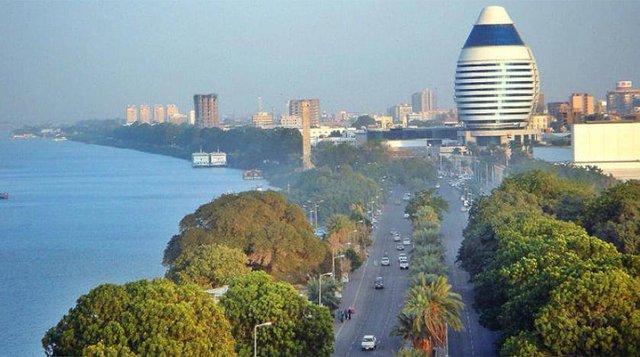Natural resources in Sudan
Minerals: Oil, Iron, Gold, Copper, Chromium, Zinc, Mica
Livestock: Camels, sheep, goats, birds and wild animals
Water and forests
Land use
Area of arable land: 200 million feddans
Area of exploited land: 20% (40 million feddans)
Permanent crops: corn, millet, wheat, cotton and peanuts
Other crops: sugar cane, dates, citrus, sun flower, maize
Irrigated land area: 11 million feddans
Land area irrigated by rain: 29 million feddans
Forest area: 11.6% of the country
Land area irrigated by rain: 29 million feddans
Forest area: 11.6% of the country
Green area in acres per capita: 1: 1.68 m
Average tree density per feddan: 200/500
Water
Total water resources: 30.8 billion m 3
Average Nile revenue in the middle: 93 billion m 3
The share of the Sudan according to (Nile Water Agreement in 1959): 18.5 billion meters 3
Egypt's share: (55.5 billion meters 3)
Water of the Nile and its tributaries
Blue Nile 50 billion meters
White Nile 27 billion meters
River Aldender 3 billion meters
Al Rahad River 1 billion meters
Atbara River 12 billion meters
Total Nile revenues in the middle: 93 billion m 3
Average annual rainfall: 400 billion m 3
Renewable groundwater: 4.02 billion m 3
Average revenue from other water sources: (rivers / valleys / Lagoons): 6 billion meters 3
Water consumption in Sudan
River Nile = 15 billion meters
Renewable groundwater = 1.02 billion m 3
Used for drinking = 0.5 billion m 3
Of which used for agriculture = 0.7 billion m 3
Total consumption of water: 18.7 billion meters 3
Availability of an improved source of drinking water in urban areas: 60%
Improved availability of drinking water source in rural areas: 78.5
The environment
International conventions signed by Sudan:
Convention on Biological Diversity
United Nations Framework Convention on Climate Change
Kyoto Protocol to the United Nations Framework Convention on Climate Change
United Nations Convention to Combat Desertification
Convention on International Trade in Endangered Species of Wild Fauna and Flora
Basel Convention on the Control of Transboundary Movements of Hazardous Wastes and their Disposal
United Nations Convention on the Law of the Sea
Montreal Protocol on Substances that Deplete the Ozone Layer
Convention on Wetlands
Average CO2 emissions: 0.3 (average per capita ton)
An advanced law for the protection of the environment was issued in 2001
Environmental Threats
Soil erosion, desertification, periodic drought and deforestation (for timber)
Natural Reserves
Reserves include rare animals, birds and coral reefs
(Dandar / Radom / Wadi Hor / Jebel al-Diyar / Jabal al-Hassaniya / Dengnab / Sanknip / Raya Basandah Qalabat)
Livestock
Livestock is one of the leading sectors that make an impressive contribution to GDP. The number of livestock is estimated at 103 million compared to 59 million in 1990/91, which includes the main supplier of red meat and its products. The rate of growth of livestock (3.6%) was at different densities, with the highest density in the states of Darfur - West Kordofan - the island and the southern states. This dairy has achieved a growth rate (19%), average meat growth rate (25%) and leather rate (19.4%) of the year
Livestock products are the main source of meat and dairy products and products (cheese, butter, yogurt, milk, etc.). It is also a major entrance in leather tanning as well as the manufacture of carcass waste (glue, gelatin, surgery nerve).
Fish Wealth
The water bodies of the country are rich in fish wealth, reaching 56% in 1999/2000. The fish are abundant in the areas of Malakal, Jabal Olya, Wadi Halfa as well as sea products in the Red Sea.
Forestry
Forests are an important natural resource that plays a role in the diversification of industrial production and can open up areas for investment and can contribute to the replacement of imported goods and commodities for export. Sudan is rich in great tree wealth, mainly tek, mahogany, seder, ebony, hashab, talh,
Columns of round and published buildings, telephone poles, furniture, sulfur factories, railway flanges, lathing, sculpture and gum arabic production.
Mineral resources
Sudan's geology qualifies it to be one of the richest countries, with rocks scattered and scattered throughout the country.
Several metals have been discovered in the country such as:
Iron, copper, chromium, lead, manganese, gold, silver and others. In addition to limestone, marble, gypsum, mica, talc, natural gas, asbestos.
HR
In addition to the natural resources, the country has been given by God rich in human resources as academic centers and institutions are organized in the development of these forces